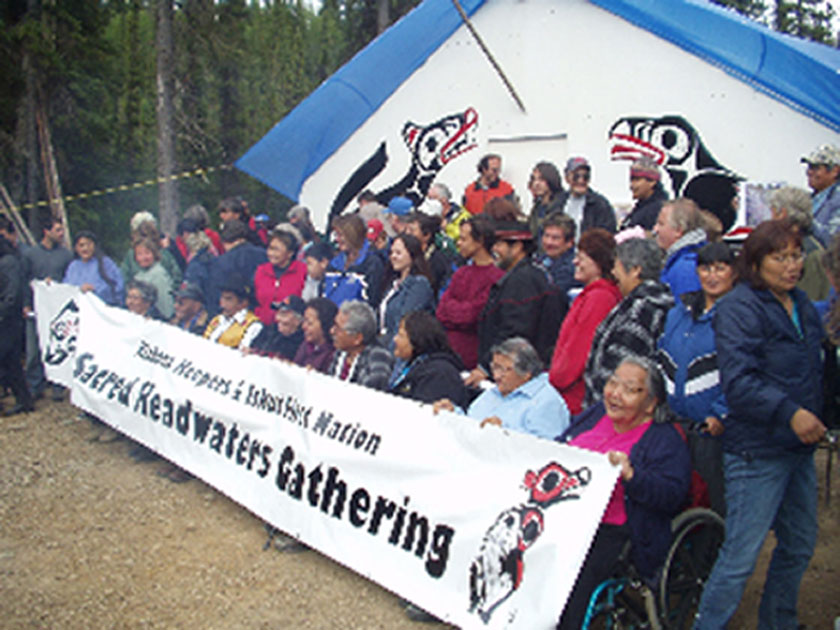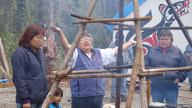Across Canada, communities and Aboriginal governments are saying they have had enough when it comes to the privileged access mining has to land under the existing system, which grants “free entry” to prospectors and mining companies under the assumption the mining is the “highest and best” use of land.
In Ontario, British Columbia, Quebec and the Northwest Territories, communities are organizing to end the free entry system.
ONTARIO
In December, in the Ontario Superior Court in Thunder Bay, Kitchenuhmaykoosib Inninuwug (KI) leadership stated that they would rather be jailed for contempt of court than allow Platinex Inc., a junior mining company, to drill on their customary homelands.
Neal Smitheman, of law firm Fasken Martineau, representing Platinex, threatened to bring in armed guards to protect the drillers. Back in February 2006, Platinex already had brought in a British mercenary to protect its mining activities.
The company has sued the First Nation for $10 billion for protecting their customary homelands. The First Nation then filed a counter suit challenging the constitutional right of Ontario to grant mineral rights on their lands without meaningful consultation. Defending their rights against the company has brought the First Nation to the brink of bankruptcy, but they continue to fight.
KI enjoys the support of the Independent First Nations Alliance and the Nishnawbe Aski Nation, which represents 47 First Nations in northern Ontario. At least ten of these First Nations have moratoriums on mineral development in their territories.
In southern Ontario, the Ardoch and Shabot Obaadjiwan Algonquin First Nations have been trying to stop Frontenac Ventures, a tiny private company, from exploring for uranium on their traditional territories. Non-native families are also concerned about staking and exploration in the area, and have organized the Community Coalition Against Mining Uranium. All are demanding changes to the Ontario Mining Act.
On December 4, 2007, Gord Miller, the Environmental Commissioner of Ontario (ECO), added his voice to the cries for change to the Mining Act, saying, “[t]his century-old system continues to rely on principles that do not reflect modern land use planning nor does it adequately safeguard environmental values.” He continued, “[t]he ECO believes that this system is reactionary and fails to determine upfront where mineral development may be inappropriate… The ECO believes that Ontario’s Mining Act and its assumption of free entry for mineral development impedes comprehensive land use planning.”
BRITISH COLUMBIA
The Iskut First Nation have been fighting incursions on their traditional territory by mining companies and coal bed methane development for over four years. In December, they won an interim injunction from the BC courts which upheld their right to keep Shell off their lands. Elder Lillian Moyer is still awaiting a court hearing on a contempt of court charge stemming from a blockade of bcMetals in September 2006.
The Takla Lake First Nation ordered prospectors off their traditional territory in September 2007. In a news release dated September 9, 2007, they stated, “Takla states it has been left with no other options to address the gold-rush that is taking place throughout the Territory and to protect Takla’s rights and Territory.”
Chief Dolly Abraham stated, “This is out of control. B.C. allows on-line staking and hands out permits to anyone who asks. Mining companies are given permits to build roads and drill in sensitive areas of our Territory. Until there is joint planning and meaningful consultation and accommodation, we will be forced to take action to protect ourselves.”
Non-native communities are also in an uproar.
Near Vernon, Rob Westie and his neighbours organized the B.C. Landowner Rights Organization in 2006 to protest free entry and the internet staking system in place in B.C., after their lands were staked by a local prospector. Examples of B.C. properties recently affected by the Mineral Tenure Act’s free entry policy:
In 2003, a company that mines clay for kitty litter entered Kamloops property belonging to the Bepples family to begin mining. The story was front page news locally for weeks.
In 2005, large areas of the Sechelt Peninsula were staked by aggregate miners who wanted to build an enormous gravel pit. Local home owners organized to try to stop the pit.
Also in 2005, a coal mining company staked the Yorston ranch, which had been in the family outside of Quesnel since 1903. The Tyee reported: “The Yorstons have 300 beef cattle, a corn maze for the summer and a picture-perfect garden. The house was built in the 1920s and Lenore’s daughter put a chicken coop out back. The land has been farmed since the 1870s.”
QUEBEC
Families living in the Outaouais area of Quebec have organized the West Quebec Coalition Against Uranium Mining (WQCAMU) after their farm, homes and cottages were staked in a uranium rush. A call for submissions on a proposed Quebec Mineral Development Strategy in fall 2007 resulted in stinging commentary about free entry and demands for change from many groups across the province, including CREAT (Conseil Régional en Environnement en Abitibi-Témiscamingue) in Rouyn Noranda, WQ-CAMU and EcoJustice.
The EcoJustice submission stated: “The Mining Act is articulated in an opaque and confusing manner, making it difficult for Québec residents, property owners and municipalities to stay informed of how the law governs their land. Based on our analysis, it is unclear how this statute interacts with other Québec laws. This lack of clarity has resulted in a legitimate concern that the Mining Act prioritizes mining rights over individual and community rights by: 1) superceding the right to privacy afforded by the Civil Code of Québec; 2) contradicting the inviolability of an individual’s home and the right to peaceful enjoyment and free disposition of property as provided for by the Quebec Charter of Human Rights and Freedoms; and 3) circumscribing the power of municipalities to protect the health and welfare of residents in accordance with the Municipal Code of Quebec and the Cities and Towns Act.”
NORTHWEST TERRITORIES
In December, 2007, the Mackenzie Valley Environmental Impact Review Board (MVEIRB) asked the Minister of Indian and Northern Affairs to end free entry on some lands in the NWT.
According to a Canadian Press story of December 17:
“It’s a system that doesn’t fully acknowledge that there are other rights of equal or perhaps greater importance,” said David Livingstone, Indian and Northern Affairs director of renewable resources and environment for the N.W.T., who spoke in favour of such a recommendation at hearings on the project.
It’s almost impossible to establish a protected area or create a land claim on land with pre-existing mineral dispositions on it, Livingstone said. “Once mineral rights are acquired, they tend to set the foundation for the discussion (for the land).
“We’ve reached a point now in the context of aboriginal rights that aboriginal people are in some cases saying ‘Hold it now, we’re not sure we want mining in this area. If you’re acquiring mineral rights, you’re setting off on that path before we’ve had a chance to really discuss the long-term consequences of that.’”
Historically, mineral rights have trumped all other uses, unless surface land is specifically withdrawn from staking, for a park, and urban development or some other special use.
The mineral rights belong to the provincial government in most parts of Canada south of the 60th parallel. In some older parts of Canada, the mineral rights are still attached to the surface lands. However, because mining taxes have to be paid on these rights, over time many of them have reverted to the Crown.
North of 60, most of the mineral rights belong to the federal government. The exceptions occur where the mineral rights were specifically awarded to a territorial or Aboriginal government through a land claims process.
The process for allocating mineral rights is usually enshrined in the provincial Mining Acts, and in the North, the Territorial Lands Act (Canadian Mining Regulations).
A Free Entry Primer
In 2004, West Coast Environmental Law published an excellent primer on the free entry system, available online as "Undermining Our Future: How Mining’s Privileged Access to Land Harms People and the Environment". There is also a handy 2-page summary: "Mining’s Privileged Access to Land: A Free Entry Backgrounder."

